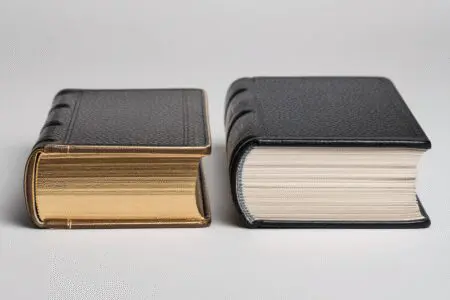Have you ever walked into a Christian bookstore or browsed online and felt a wave of paralysis? Staring at a wall of Bibles, each one claiming to be the key to unlocking Scripture, can be completely overwhelming. I remember that feeling distinctly. Years ago, I just wanted a Bible that would help me understand God’s Word on a deeper level, but I ended up with more questions than answers. Which translation is best? Do I need all these maps and charts? What if I pick the “wrong” one?
If that sounds familiar, take a deep breath. You’re in the right place. The quest to answer the question, What is the best study Bible?, isn’t about finding a single, perfect book. Instead, it’s about finding the perfect tool for your personal journey with Christ. This guide is born from my own experience and countless conversations with pastors, scholars, and everyday believers. We’re going to walk through this together, breaking down the options so you can choose with confidence and joy.
More in Bible Category
What Is the Best Cross Reference Bible
Which Bible Translation Should I Read
Key Takeaways
- The “Best” Study Bible is Personal: The ideal choice depends entirely on your personal study goals, preferred translation, and theological leanings. There is no one-size-fits-all answer.
- Translation Matters Most: Before picking a study Bible, understand the difference between “word-for-word” (like ESV, NASB) and “thought-for-thought” (like NIV, NLT) translations to find one that resonates with your reading style.
- Features Serve a Purpose: Study notes, cross-references, concordances, maps, and book introductions are the tools that transform a regular Bible into a powerful study resource.
- Consider the Source: The study notes in every Bible are written from a particular theological perspective. It’s helpful to know what that perspective is.
- Don’t Replace Scripture with Notes: A study Bible is a guide. Always read the biblical text itself first before turning to the commentary for deeper insight.
Why Do You Even Need a Study Bible?
First things first, what separates a “study Bible” from the one you might see in a hotel nightstand? A standard Bible contains the inspired text of Scripture, which is powerful and complete on its own. A study Bible, however, is that same text surrounded by a library of resources designed to illuminate it.
Think of it like visiting a foreign country. You could explore on your own and have a wonderful time. But if you went with a knowledgeable local guide, you’d understand the history, culture, and language on a profoundly deeper level. That’s what a study Bible does. It acts as your personal guide to the world of the Bible. It doesn’t add to God’s Word, but it does provide a wealth of context that the original readers would have understood implicitly.
I had a moment with this years ago reading the book of Amos. On its own, the text felt a bit dry and distant. But when I flipped to the study notes, they explained that Amos wasn’t a priest or a prophet by trade; he was a simple shepherd and fig farmer. God called this ordinary guy to deliver a powerful message. Suddenly, the entire book clicked for me. It wasn’t just ancient history; it was a testament to how God uses regular people. That’s the magic of a good study Bible.
How Do You Choose the Right Bible Translation?
Before we can even talk about study notes and features, we have to address the foundation: the translation. Bible translation isn’t an exact science; it’s a philosophy. Translators must decide how to best carry the meaning from the original Hebrew, Aramaic, and Greek into modern English. Generally, their approaches fall into two main categories.
What are the best Word-for-Word (Formal Equivalence) Translations?
These translations prioritize staying as close as possible to the structure and wording of the original languages. They are excellent for deep, technical study because they give you a clearer window into how the sentences were originally constructed.
- New American Standard Bible (NASB): Often considered one of the most literal English translations available. It’s fantastic for precise word studies but can sometimes feel a bit stiff or wooden in its phrasing.
- English Standard Version (ESV): This has become a modern standard for a reason. It beautifully balances word-for-word accuracy with literary excellence and readability. It’s a workhorse translation that is excellent for both study and daily reading.
- King James Version (KJV): The historic standard of the English-speaking church for centuries. Its majestic, poetic language is beloved by many. However, its archaic language (words like “thee” and “thou”) can be a significant hurdle for modern readers.
What are the most popular Thought-for-Thought (Dynamic Equivalence) Translations?
These translations prioritize conveying the original meaning or thought of a passage over sticking to the exact sentence structure. The goal is to produce a text that would have the same impact on a modern reader as the original text had on its ancient audience. They are often much easier to read.
- New International Version (NIV): For decades, the NIV has been the world’s most popular English Bible. It strikes an incredible balance between accuracy and easy readability, making it a fantastic choice for new believers, small groups, and public reading.
- New Living Translation (NLT): The NLT leans even more toward readability. It reads smoothly, almost like a story, which can be wonderful for devotional reading and for getting a broad overview of a passage’s meaning.
Should I consider a Paraphrase Translation?
Paraphrases, like Eugene Peterson’s The Message (MSG), take the thought-for-thought philosophy a step further. They are not translations in the strict sense but rather a retelling of the Scripture in contemporary, everyday language. While a paraphrase can be a fantastic tool to see a passage with fresh eyes, it’s generally not recommended as your primary Bible for in-depth study.
So, which is best? For serious study, I personally lean toward the ESV or NASB. However, I often read the NLT for my daily devotions because of its warmth and clarity. The best advice is to read the same chapter (like John 3 or Psalm 23) in several translations and see which one speaks most clearly to your heart.
What Features Should I Look for in a Great Study Bible?
Once you’ve landed on a translation, it’s time to look at the “study” part of the study Bible. These features can vary wildly, so it’s important to know what you’re looking for.
How Important Are the Study Notes and Commentary?
This is the heart and soul of any study Bible. The notes, usually found at the bottom of each page, provide explanations of difficult verses, historical and cultural context, and definitions of key terms. The crucial thing to understand is that these notes are written by fallible humans. They represent a specific theological perspective. Some Bibles, like the ESV Study Bible, have notes informed by a Reformed (or Calvinistic) viewpoint. Others, like the Life Application Study Bible, are more broadly evangelical. There is nothing wrong with this, but it is something to be aware of. You are choosing a guide, so it’s wise to choose one you generally trust.
What Are Concordances and Cross-References?
A concordance is like an index for the Bible. It’s an alphabetical list of important words and tells you where they appear. Want to find every verse that mentions “grace”? The concordance is your friend.
Cross-references are even more powerful. These are small notes, often in a central column, that point you to other related verses in the Bible. This is one of the best ways to practice the principle of letting Scripture interpret Scripture. You’ll start to see how the story of God’s redemption is woven through the entire Bible, from Genesis to Revelation.
Are Maps, Charts, and Timelines Actually Helpful?
Absolutely! It’s one thing to read about the Apostle Paul’s missionary journeys; it’s another thing entirely to trace his route on a full-color map. Seeing the actual geography makes the stories come alive. Likewise, charts that break down the kings of Israel and Judah or timelines that place biblical events in the context of world history are invaluable tools. They help ground the biblical narrative in the real world.
What About Book Introductions and Character Profiles?
Before you dive into a new book of the Bible, a good introduction is a game-changer. It will typically tell you:
- Who wrote the book
- When it was written
- Who the original audience was
- The primary themes and purpose of the book
Reading this first is like getting the lay of the land before a long hike. It provides the essential context you need to understand what you’re about to read. Some study Bibles also include profiles of key biblical figures, which can be very insightful.
Which Specific Study Bibles Do Experts and Pastors Recommend?
Alright, let’s get down to brass tacks. While there are dozens of excellent options, a few consistently rise to the top in recommendations from pastors, scholars, and seasoned believers.
Is the ESV Study Bible the Best Overall Choice?
Many would say yes. The ESV Study Bible is a titan in the world of study Bibles. It is incredibly comprehensive, containing over 20,000 study notes, 200 maps, 40 illustrations, and numerous articles on theology, ethics, and archaeology.
- Who it’s for: This Bible is perfect for the serious student, the pastor, or anyone who wants to go as deep as possible. If you want a one-volume seminary education, this is as close as you can get.
- Things to Consider: It is massive and heavy, definitely not a Bible you casually toss in a backpack. As mentioned, its notes come from a broadly Reformed theological perspective.
What Makes the NIV Study Bible So Popular?
The NIV Zondervan Study Bible is another powerhouse. Using the highly readable NIV translation, it has been a trusted resource for decades. The latest editions are in full color and are visually stunning, making the maps, charts, and photos truly pop.
- Who it’s for: This is an amazing all-around choice for just about anyone. It’s accessible enough for a new Christian but has enough depth for a seasoned saint. It’s a fantastic option for small group leaders and Sunday School teachers.
- Things to Consider: Its notes are written by a team of scholars from a wide range of evangelical traditions, so they tend to be more balanced and less focused on one specific theological system than some other Bibles.
Why Should I Consider the Life Application Study Bible?
This is one of the best-selling study Bibles of all time for a simple reason: its focus is crystal clear. Every note and feature is geared toward answering the question, “So what?” It constantly pushes you to think about how a particular passage applies directly to your career, your family, your struggles, and your faith.
- Who it’s for: If you are a new believer or if your primary goal in reading Scripture is personal growth and practical application, this Bible is for you. It excels at bridging the gap between the ancient world and your modern life. It most commonly uses the clear and easy-to-read NLT.
- Things to Consider: It is intentionally less focused on deep historical context, original languages, or systematic theology. It’s a “how-to” guide more than a “what-it-is” guide.
What is the MacArthur Study Bible Good For?
The MacArthur Study Bible is unique because all of its nearly 25,000 notes were written by one person: the respected pastor and teacher John MacArthur. This provides a remarkable level of consistency and depth from a single, trusted pastoral voice.
- Who it’s for: This Bible is for the student who appreciates a clear, authoritative, verse-by-verse explanation from a seasoned guide. If you listen to John MacArthur’s sermons, you will feel right at home in this Bible. It’s available in several translations, including the NASB and ESV.
- Things to Consider: Because it’s from a single perspective, you won’t be presented with alternative interpretations of difficult passages.
How Does a Digital Study Bible Compare to a Physical One?
In our digital age, you don’t have to carry a ten-pound book to have a study Bible. Digital Bible apps like Logos, Olive Tree, and Blue Letter Bible are incredibly powerful.
The Case for Digital:
- Portability: You can carry an entire library on your phone.
- Searchability: You can search for a word or phrase across the entire Bible in seconds.
- Customization: You can have multiple translations and commentaries open side-by-side.
The Case for Physical:
- No Distractions: A physical book doesn’t have notifications popping up.
- Tactile Engagement: For many, the act of highlighting, underlining, and writing notes in the margins is a key part of learning and remembering.
- Spatial Memory: It’s often easier to remember where a passage is located on a physical page.
Many people find that a hybrid approach works best. A physical Bible for focused, devotional study at home, and a digital Bible for when you’re on the go or need to do a quick search. For those interested in exploring the world of digital biblical studies, many academic institutions provide excellent resource guides. For instance, Yale Divinity School Library offers a comprehensive guide to biblical studies resources that can be incredibly helpful.
How Can I Get the Most Out of My New Study Bible?
Buying the Bible is the easy part. The real joy comes from using it. Here are a few tips to get you started:
- Pray First: Always begin your study time by asking the Holy Spirit to open your heart and mind to His truth.
- Read the Introduction: Before starting a new book, read the study Bible’s introduction to it. It will give you your bearings.
- Text Before Notes: Make it a habit to read the biblical passage first. Wrestle with it on your own. Then, read the study notes to deepen your understanding or clarify confusion. The notes are the commentary; the text is the main event.
- Chase the Rabbits: When a cross-reference catches your eye, look it up! Chasing these “rabbit trails” is one of the best ways to see the beautiful, interconnected tapestry of Scripture.
- Engage with the Text: Don’t just be a passive reader. Keep a journal nearby. Write down your questions, your prayers, and what God is teaching you.
Your Partner in Faith
In the end, the search for the best study Bible is a deeply personal one. The ESV Study Bible might be perfect for a seminary student, while the Life Application Study Bible might be the catalyst that ignites a new believer’s faith. Don’t worry about what everyone else is using.
Think about your own walk with God. What do you need right now? Do you need clarity and practical steps? Do you need deep, historical context? Do you need the encouragement of a trusted pastor?
Answering those questions will lead you to the right choice. Because the best study Bible isn’t the one with the most notes or the fanciest cover. It’s the one that you’ll open day after day. It’s the one that will become worn and highlighted, stained with coffee and tears. It’s the one that will be a faithful tool in the hands of the Holy Spirit to shape you, challenge you, and draw you closer to Jesus.
Frequently Asked Questions – What Is the Best Study Bible

How can I select the most suitable study Bible based on physical quality and key features?
Choosing a study Bible with durable sewn binding, quality paper that does not bleed through, and a long-lasting cover like genuine leather or high-quality imitation leather will ensure longevity; also consider helpful features like maps, charts, and comprehensive concordances.
What features should I look for in a study Bible aimed at seasoned scholars or pastors?
Seasoned scholars or pastors should look for a study Bible with a more precise translation such as ESV or NASB, extensive notes, articles, and detailed explanations of original Hebrew and Greek words.
What should I consider when choosing the best study Bible for a beginner?
For beginners, it is best to choose a study Bible that uses an easy-to-read translation like NIV or NLT, has clear notes explaining the main points, and features a simple, user-friendly layout.
Why should I invest in a good study Bible for my spiritual growth?
Investing in a good study Bible is valuable because it provides deeper context of biblical events, helps answer difficult questions through trusted notes, and supports personal growth by connecting scripture with everyday life applications.
What is a study Bible and what features does it include?
A study Bible is a version of the Bible that includes additional features such as study notes, book introductions, cross-references, maps, charts, articles, and a concordance, all of which help improve understanding and provide deeper insights into the scriptures.




